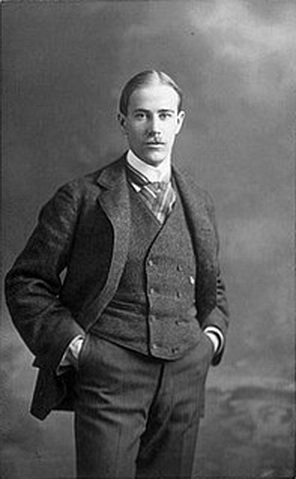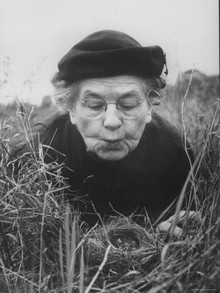On the Wing #45: (BRO) Fuertes Vs. Nice
The final round of the first round begins now. Famous northeastern bird artist Louis Aggasiz Fuertes vs. the queen of the Song Sparrows (Melospiza melodia), Margaret Morse Nice. But first, a quick side note! The next rounds will be focusing on an important idea advanced by the participants who won in this first round. While it might not be a famous idea like Darwin's finches or Griscom's field work, it has to have had a significant impact on the birding or ornithological world in order to have sway. Just wanted to give you guys a heads up for next week. Anyhoo, back to the contest! Lets get it started!
Louis Agassiz Fuertes (1874-1927) is one of America's most renowned bird artists behind John James Audubon. He produced thousands of works in his life, usually from fresh specimens he collected himself. An eager practitioner of Coues' Golden Rule (a bird in hand is worth two in the bush), he collected specimens using a slingshot and drew many of his first works from those very specimens. Later, in his teen years, a friend introduced him to that very man, Elliott Coues and from there, Coues helped to spread and foster Fuertes reputation and fame as a bird artist. His notoriety as an artist grew after his work appeared in many ornithological works of both his own research and based on his clienteles needs. He also worked closely with Frank Chapman of the American Museum of Natural History where he assisted in the creation of diorama backgrounds, illustrations, and field research. As well as participating in his own field expeditions, he also had an oriole named after him by Chapman while on a collecting trip in Mexico. Fuertes's Oriole (Icterus fuertesi) is actually a subspecies of Orchard Oriole (I. spurius), but under some authorities, remains split as separate species. Before a fatal car accident took his life in 1927, he was made an honorary scout by the Boy Scouts of America for his "…achievements in outdoor activity, exploration
and worthwhile adventure…" In addition to this prize, Fuertes also had an award named after him by the Wilson Ornithological Society. Certainly a man of many talents, Louis Agassiz Fuertes seems to have had a hand in everything bird-related for a good part of the late 19th to early 20th century.
Margaret Morse Nice (1883-1974) is a legend among women naturalists and scientists. She is most famous for her studies with Song Sparrows, but also conducted research on other passerines like robins and flycatchers. She became well acquainted with birds as a young girl and kept meticulous field notes as a teenager. So meticulous were her records, that it was many years later, when she was able to decipher the changes in breeding behavior of the birds she had observed up to six decades earlier! One of only two women graduates from Clark University in 1915, she went on to produce the first comprehensive study of the diet of the Northern Bobwhite (Colinus virginianus). From 1929-1936, she engaged in an eight year study of the breeding habits of the Song Sparrow with an emphasis on interactions, instinct, breeding, and song learning. Her research put her on the map as one of the most influential ornithologists of the 20th century and earned her the Brewster Medal in 1942. Later on she became the first woman president of the Wilson Ornithological Society and gained a fellowship with the American Ornithologists Union (vowing to fight the causes of hypothermia in cormorants, boobies, and other sulids since 1883). She also spent two months studying the behavior of captive birds in 1938 with Konrad Lorenz, the famous Austrian ethologist and ornithologist. After she died in 1974, she had written 250 papers, 3000 book reviews, and several books including "Birds of Oklahoma" and her own autobiography. Also after her death, the Margaret Morse Nice Medal was created by the Wilson Ornithological Society to recognize those individuals who have done an extensive study in a particular aspect of avian behavior or life history. A woman with a wide reach and audience, Nice was further proof for deepening the reach and influence women scientists have had and will continue to have on the field of ornithology for years to come.
This final one's going to be a toughie, but the scores must be tabulated!
Fuertes:
By a hair, Margaret Morse Nice wins! This concludes the first rounds of the Babe Ruth of Ornithology. After this is posted, an updated brackets will be posted shortly after the posting of this result. Thanks for watching and see ya'll next week. And as always, happy birding!
 |
| As dapper as his paintings, one can see how he grew to rival the work of Audubon |
 |
| The sparrows needn't have worried. For she'd only come to check out the decor. |
This final one's going to be a toughie, but the scores must be tabulated!
Fuertes:
- One of America's most renowned bird artists, he is just behind Audubon in terms of recognition, skill, and variety. (1)
- A practitioner of Coue's Golden Rule, he sought and collected specimens from an early age to practice painting and drawing from as well as for nature study (-1/2)
- His introduction to Elliott Coues doubled his fame and the public's interest in his skills as an artist. (1)
- Produced a great volume of work for many clients including art collectors, authors, and scientists. (1)
- Worked closely with Frank Chapman of the American Natural History Museum to produce backgrounds for dioramas and illustrations, as well as conducting his own field research. (1)
- Has a subspecies of Orchard Oriole named after him (1)
- Made an honorary scout by the Boy Scouts of America for promoting nature study and exploration of the natural world. (1)
- Had an award named after his death by the Wilson Ornithological Society. (1)
- Was most famous for her studies on the breeding behavior and life history of the Song Sparrow. (1)
- Kept meticulous notes on the birds that lived near her as a young girl. They were so well kept, that years later she could use them for future research purposes. (1)
- Earned the Brewster Medal for her work with Song Sparrows. (1)
- Became the first woman president of the Wilson Ornithological Society (1)
- She wrote over 250 papers, 3000 book reviews, several books of her own, and an autobiography of her work and life. (1)
- One of the most well known women scientists in her field and contributed much in many parts of it. (1)
- Had a medal named after her death which recognized those who had conducted an extensive research project to a particular aspect of avian life history or behavior. (1)
By a hair, Margaret Morse Nice wins! This concludes the first rounds of the Babe Ruth of Ornithology. After this is posted, an updated brackets will be posted shortly after the posting of this result. Thanks for watching and see ya'll next week. And as always, happy birding!


Comments
Post a Comment